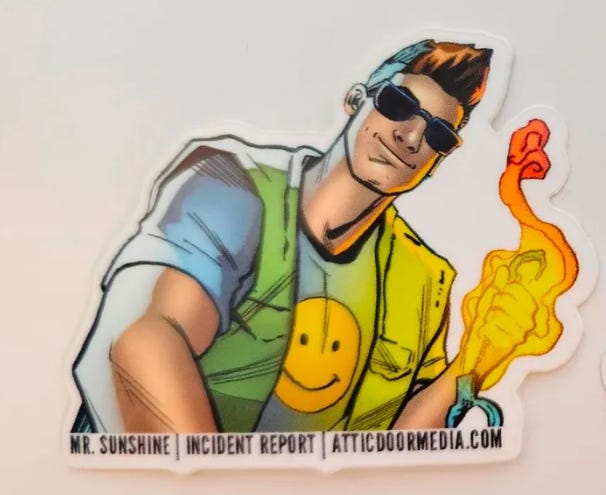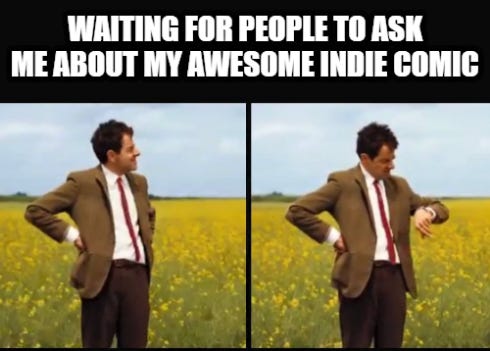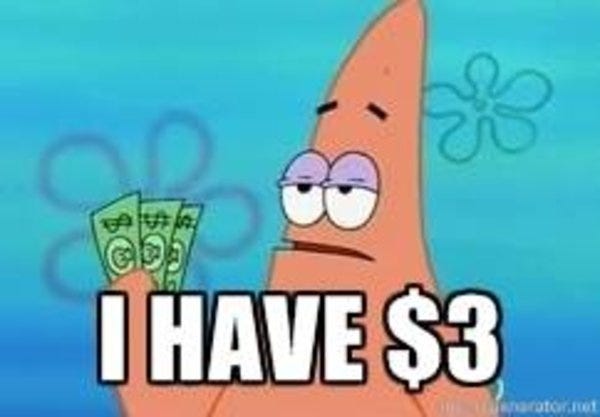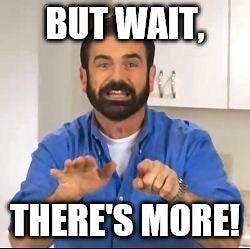How We Pitch at Conventions
An Overly Long Guide to How We Convince Strangers to Give Our Comics a Chance
We’ve developed a strategy for pitching at conventions, especially pitching multiple series, without overwhelming people. In fact, we’ve even had con-goers compliment our strategy after buying our books. (Seriously. Multiple times. People really love stickers.)
First, though, the boilerplate. This article is part of a series, and once all five parts are complete, they’ll live on our Substack. If you missed the first article—which also has links to the rest of the series as they come out—you can find it here: We Can Convention and So Can You!
So, how do we at ADM approach pitching our IP at conventions?
This article will be in 2 parts: guiding principles that help make our pitching more successful, and the pitch itself.
But to get you started, here’s a tl;dr:
Stay positive. Don’t take rejection personally.
Be proactive about talking to people who pass by. Don’t wait for them to come to the booth.
Don’t pull people out of your neighbors’ booths. Pitch to an individual. Don’t shout at a crowd — or worse, at an empty row.
Offer something small, interesting, and free to get their attention. We turned our business card into a sticker with art from our book.
Break your pitch into stages. Keep your initial pitch extremely brief. Then, if they stick around, add detail.
If you make it through a full pitch, end it by explicitly mentioning the price.
If they don’t buy, offer them your email signup list.
If they do buy, offer them your email signup list — and take their picture.
Guiding Principles
The attitude we bring to our pitches is important to our success. People feed off your energy, so if you’re flagging, stressed, or preoccupied. So how do you keep your head in the game?
Straight Up Gratitude
Gratitude is how we stay positive hour after hour at conventions. But it can be hard to maintain it. After all, part of pitching is getting rejected. A lot. Sometimes, a bunch of times in a row. It’s easy to get discouraged and feel bad, which can make your future pitches less successful. Attention is a precious and limited resource in a loud and overwhelming world. Nobody on the convention floor owes us their time. If someone takes the sticker and walks off before we can give them a pitch, or even says “No, thank you” to the sticker before continuing on with their day, we’re sincerely grateful for that interaction. And if they stop to hear our pitch? Wow. That’s awesome! We’re total strangers, and this person was willing to give us their time so we could tell them about a cool thing that we made. Each stage of the interaction is a tiny success–a gift from a stranger. Not every pitch will result in a sale, but each engagement that someone has with us is a win.
“Read Me”
This isn’t a programmer’s README file. This is our free-to-peruse copy of comic issues, right on the table for any con-goer to flip through. If you’re like us, you’ve spent too many hours sitting on the floor at Barnes & Noble reading through a stack of manga or novels you never bought. Con-goers aren’t any different. Some want to browse, some want to stand and skim. That’s fine by us.
Turnabout is fair play. We’re carrying books for others to consume, and we’d rather encourage reading than discourage it. If someone blocks traffic, we politely guide them to the side, but never ask them to stop. Avid readers often become avid supporters.
Passivity Means Anonymity
When you’re an indie comic creator, you’re at a disadvantage right out of the gate. People don’t know your label the way they know Marvel. They don’t know your IP the way they know Spider-Man or Batman. That means you’ve got to put your work forward.
This can be tough. Many creators are introverted, preferring to communicate through their work. But conventions demand that you get past that. You have to pitch your heart out. So don’t just sit back and hope people notice you as they stroll past. They need to know why they need your work in their life.
Be Engaging, Not Overbearing
Yes, you need to grab attention. But don’t be obnoxious about it. Con etiquette is important. You want to be remembered as someone fun to share a row with, not someone who soured the vibe.
The con scene is a community. There’s a lot of camaraderie among vendors. We’ve had conversations with other creators that gave us tips on product design and convention strategy. We even played D&D by passing notes. You don’t want to be that person everyone avoids in Artist Alley.
Don’t drag people away from a neighbor’s table. It’s worth saying twice: Don’t pull people out of a neighbor’s booth. Especially in artist alley, indie creators have the potential to be disruptive to our neighbors. Focus on attendees who are walking past or who make eye contact. If they’re eying another vendor’s booth let them shop. Target your attacks: Pitch to specific people. Don’t shout into the void like a carnival barker.
The Pitch Process
Alright, so you’ve caught someone’s attention. They’re slowing down near your table. You’re ready to engage. What do you do? This is where our pitch workflow comes in.
The Loss Leader
Stickers. Everyone loves them. They’re inexpensive, they’re fun, and they’re your hook. A simple “Would you like a free sticker?” is an easy way to get people to pause. For us, it costs about $0.06 per sticker. Even if someone takes one and leaves, our website is on it, which means our website is now in their hands. And they come out of your pitch feeling happy, since you’ve just paid them for their time.
Think of it as spending pennies for pitches.
Also, the stickers are awesome: we use art from the book. If people like the stickers and think they’re cool, they’ll probably like the art in the book.
Accept or Refuse
Some people won’t take the sticker. Maybe they’re late for a cosplay contest or just not in the mood. That’s fine. Let them keep walking. Maybe they hate joy (kidding!). We always prefer for someone to refuse the sticker than to take it if they don’t really want it. Because there are people who *love* stickers and would be excited to get it.
Sometimes, even without taking the sticker, people pause long enough to peek at your books. That’s when you invite them to read through your “Read Me” copies.
And if they do take the sticker? Great. Some might leave right after, but many will stick around long enough for you to give them a quick pitch. Offering a freebie buys you that sliver of attention.
The Pitch Itself

Here’s where the fun begins. We offer different stickers featuring characters from our IPs. Maybe they pick Mr. Sunshine, the fire-powered local who we lovingly refer to as the fabled Florida Man™. Maybe they pick Prince Kavan, a royal runaway searching for his kidnapped sister. Once they choose, we flip to the page in the comic where that character appears, give a short description, and let them browse through the comic on their own.
It’s a choose-your-own-adventure moment. You tailor the pitch to what *they* picked. And yes, you are basically a dungeon master for their five-minute con quest. And you don’t give them the sticker until you’ve gotten started on who that character is! Consider it an equivalent exchange for the sticker.
Time to Converse
Now they’re flipping through your book. This is where you shift gears into conversation. Pay attention to their cues. If they’re wearing a Marvel shirt, we highlight some of the superpowers. If they’ve got a lightsaber prop, we lean into our sci-fi/fantasy characters. This is also where being a geek yourself pays off. We’re trekkies. Someone mentions Trek, we could talk for hours. But the goal is to loop it back to your own comic. Connect the dots between their fandoms and your stories.
At this point, you also want to:
Offer a longer pitch if they ask for more details.
Remind them you’re a local creator (if it’s true)
Pivot if they clearly show interest in another title on your table.
Closing the Pitch
If they’ve stuck around for a longer pitch and conversation, make sure you mention the price of the book. Even if the price is clearly marked on the table. Cons are visually overwhelming, and it’s easy to miss things. If a person is confused, they won’t buy. It’s okay if they’re not ready to purchase today, but make sure they know how much it would cost.
When They Don’t Buy
Not everyone will buy, and that’s okay. But that doesn’t mean the interaction is wasted. This is your chance to collect data—specifically, their email.
We always keep a digital sign-up form open on one of our phones. The pitch is light: “You’ll get free samples of our ongoing work and yes, photos of our dogs.” People love the dog angle. And yes, the dogs get plenty of treats for their service.
When They Do Buy
If you land the sale, congrats! But don’t let the interaction stop there. Offer to sign the book. Many people don’t know they can ask you for this, or think it might be an extra charge. Let them know it’s an option.
While signing, hand them a device where they can put in their email and invite them to subscribe. Mention that you’ll keep them updated on new issues.
Once they’re paid up, ask them if they’ll let you take their picture with your comic. This is your social proof for future campaigns: all the cool people who already like and read your books! Celebrate this on social media and tag people if you know their handles.
Practice Makes Progress
“Fail Fast” is a common saying in startups. For the last two years, we’ve been trying to do as many conventions as we can (honestly, probably too many conventions), sometimes on back-to-back weekends. Why? To learn as much as we can. We made a lot of mistakes. That’s okay. The key is practice. The main thing we learned: books don’t sell themselves sitting on a table. You’ve got to work the crowd.
Here’s how our last Con shook out for us:
Table Cost: $540 for two Artist Alley tables and four exhibitor passes.
Hotel Cost: $0 (it was local, so no travel expenses)
Results: Over 100 new email sign-ups, $1,100 in revenue, and a margin above 50%
That’s a win. But the bigger victory is the list of potential fans we now have for future campaigns. The larger our following grows, the easier it will hopefully be to fund projects.
Wrapping Up
How do you pitch at conventions? Are there any tips and tricks that work for you?
Have you had any especially good neighbors at a con?
Did you ever get stuck in a rut at conventions? How did you get out of it?
What was your all-time favorite interaction with a person who stopped at your booth?
What’s your strategy for email signups?











